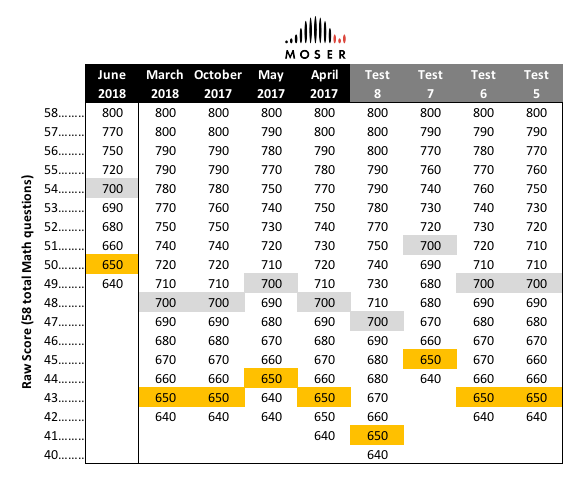#rescoreJuneSAT
By Moser Educational Services | July 14, 2018

You’ve undoubtedly heard by now of the latest viral hashtag: #rescoreJuneSAT. Yes, you read that correctly! It’s rare that boring standardized exams make national headlines, but it happened yesterday when students and parents reacted strongly to perceived unfairness in the scoring of the June 2nd SAT.
So, what caused the perceived injustice? Put simply, the Math section – which constitutes half of the exam – was incredibly easy. Yes, you read that correctly too. According to all the publicly available data, the Math section was the easiest it has ever been since the exam was completely overhauled in the Spring of 2016.
To understand this issue further, we need to go down a short rabbit hole. So, please bear with us. In order for standardized tests to be of any value, it needs to be possible to compare scores from multiple exam dates (i.e., across multiple months and years). But, the difficulty for test-makers is that they cannot simply administer the same test over-and-over again. As a result, they use a statistical process called “equating” to adjust a student’s raw score (total number of questions answered correctly) to a “scaled score.” This process statistically adjusts scores on different versions of the test to compensate for differences in difficulty, which are usually quite small. Test-makers have been doing this for a long time now, and they are usually pretty good at it.
When we examined the June 2nd Math section scoring chart in depth here is what we discovered: students who got fewer questions wrong than they have on past exams actually scored significantly lower this time around. For reference, we’ve crunched the numbers on the SATs we have access to and included the data below.
The first column (numbers 58 through 40) represents a student’s “raw score,” a fancy way of saying the number of questions they answered correctly. As you can see, there are 58 total Math questions and, of course, answering all of them correctly results in a perfect score of 800.
The other numbers represent the “scaled score” on the traditional 200 to 800-point scale that corresponds with a given raw score. The second column represents the most recent June 2nd exam. And, the subsequent columns represent the most recent SATs for which public data is available. The four columns on the far right are from the College Board’s published book of 8 practice tests. We included data from only four of these tests because these were the only ones that were actually administered.

As you can obviously see, the June 2nd exam was incredibly easy relative to the others, and it punished the highest performing students scoring 650 (86th percentile) or higher. Anecdotally, a student could miss only 4 questions to get a 700 (92nd percentile.) On the March exam, a student could miss 11 questions, which is about average (see gray highlighted cells). And, a student could miss only 8 questions to get a 650. While in the past, a student could miss on average 15 questions to receive this same score.
Essentially, when the test was “equated”, it amounted to an incredibly harsh “curve.” Statistically speaking, the College Board’s methodology is sound. But, there are several qualitative considerations:
- The equating was performed before the test was even given, so it’s worth saying that the Collegeboard knew the June 2nd Math portion of the exam was really easy, which meant students could not afford to miss many questions. Why the College Board would administer this exam when this type of backlash was predictable is a topic for a different debate.
- The real problem is that this particular test makes is almost impossible to distinguish among high performers, those scoring 650 or higher. And, colleges look at these scores closely as an accurate indicator of Math ability and as a way to differentiate students during the admissions process. Put differently, on this exam it was impossible for a student to receive a score of 790, 780, 760, 740, 730, etc.
- Finally, extremely easy tests put students under even more pressure because making one simple mistake or mis-bubbling one question has serious ramifications.
While it’s somewhat counter-intuitive, we greatly prefer our well-trained, well-prepared students actually take “harder” tests. And, now you can see why…
The most concerning part of this entire fiasco (which no one is talking about) is why the Collegeboard removed two Reading questions and two Writing & Language questions from the scoring of the exam. This has happened in the past on a much more limited basis, and the Collegeboard never explains why or how it affects the scoring of the exam. Questions only get removed from the test for one reason: the questions were broken. In other words, a much larger number of students answered these broken questions either correctly or incorrectly than anticipated, so the questions were essentially thrown out.
In conclusion, students shouldn’t dwell too much on their Math score and should instead focus on preparing to take the exam again. For the first time, the SAT will be offered in August this year. But, the real winner in all of this was the SAT’s fiercest competitor: The ACT. Remember, more students now take the ACT than the SAT. So, if you haven’t considered the ACT yet, maybe it’s time to do so.
As always, we pride ourselves on being an educational resource to the community. We are available 24/7 to answer your questions and chat about your particular needs. Do not hesitate to contact our Founder and President Scott Moser at (303) 318-4328 or via email at scott@mosereducational.com.
